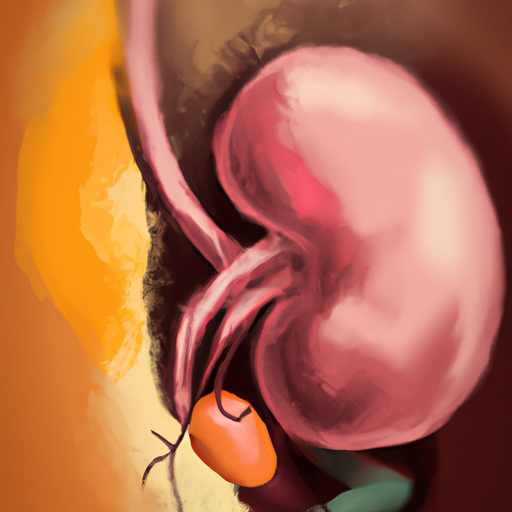- Your cart is empty
- Continue Shopping
Breaking Down Kidney Stones: From Diagnosis to Prevention – A Comprehensive Guide

Kidney stones can be an excruciatingly painful condition that affects millions of people worldwide. These small, hard deposits that form in the kidneys can cause a range of symptoms, from mild discomfort to severe pain. Understanding the causes, symptoms, and diagnosis of kidney stones is crucial in order to effectively manage and treat this condition. In this article, we will explore everything you need to know about kidney stones, including their causes, symptoms, and how they are diagnosed. We will also delve into the various treatment options available, from medications to surgical procedures, and discuss the importance of prevention and lifestyle changes to avoid the formation of kidney stones. Whether you have experienced kidney stones before or simply want to learn more about this common condition, this article will provide you with valuable information to help you navigate through the complexities of kidney stone diagnosis, treatment, and prevention.
1. Understanding Kidney Stones: Causes, Symptoms, and Diagnosis
Kidney stones, also known as renal calculi, are hard deposits made up of minerals and salts that form in the kidneys. These stones can vary in size, ranging from as small as a grain of sand to as large as a golf ball. While small kidney stones may pass through the urinary tract unnoticed, larger stones can cause severe pain and discomfort.
Understanding the causes of kidney stones is essential in preventing their formation. The most common type of kidney stone is calcium oxalate, which forms when there is an excess of calcium and oxalate in the urine. Other types include uric acid stones, struvite stones, and cystine stones, each with their own distinct causes.
Several factors contribute to the development of kidney stones. Dehydration is a significant risk factor, as it can lead to concentrated urine and increase the likelihood of stone formation. Certain medical conditions, such as urinary tract infections, kidney disease, and genetic disorders, can also increase the risk. Additionally, lifestyle factors like a diet high in sodium and animal protein, as well as obesity, can play a role in kidney stone formation.
Recognizing the symptoms of kidney stones is crucial for early detection and treatment. Common symptoms include severe pain in the back or side, often radiating to the lower abdomen and groin. This pain, known as renal colic, can come in waves and may be accompanied by blood in the urine, cloudy urine, frequent urination, and a strong urge to urinate. Nausea, vomiting, and fever may also occur, especially if an infection is present.
Diagnosing kidney stones typically involves a combination of medical history evaluation, physical examination, and imaging tests. The doctor may ask about the patient’s symptoms, medical history, and lifestyle habits. Physical examination may reveal tenderness or pain in the affected area. To confirm the presence of kidney stones and determine their size and location, imaging tests such as ultrasound, X-ray, CT scan, or MRI may be ordered.
In conclusion, understanding the causes, symptoms, and diagnosis of kidney
2. Treatment Options for Kidney Stones: From Medications to Surgical Procedures
Treatment options for kidney stones can vary depending on the size, location, and composition of the stone, as well as the severity of symptoms experienced by the patient. The treatment approach can range from conservative measures to more invasive surgical procedures. Here, we will explore the various treatment options available for kidney stones.
1. Conservative Management:
In cases where the kidney stones are small and causing minimal discomfort, conservative management may be recommended. This approach involves drinking plenty of fluids, especially water, to promote increased urine output. Increased fluid intake helps flush out the stone from the urinary system. Pain medications, such as nonsteroidal anti-inflammatory drugs (NSAIDs) or opioids, may be prescribed to alleviate pain and discomfort during the passage of the stone.
2. Medications:
Certain medications can be prescribed to aid in the treatment of kidney stones. For instance, alpha blockers, such as tamsulosin, help relax the muscles in the ureter, facilitating the passage of stones. Additionally, medication such as thiazide diuretics can be used to reduce the production of urine and prevent the formation of new stones. However, it is important to note that medications alone are not always effective in treating larger stones or those causing severe symptoms.
3. Extracorporeal Shock Wave Lithotripsy (ESWL):
ESWL is a non-invasive procedure commonly used to treat kidney stones. It involves using shock waves generated outside the body to break the stone into smaller fragments, making it easier for them to pass through the urinary tract. ESWL is typically performed under sedation or anesthesia, and the patient may experience some discomfort during the procedure. Afterward, the stone fragments are usually passed naturally within a few days or weeks.
4. Ureteroscopy:
Ureteroscopy is a minimally invasive procedure that allows the urologist to directly visualize and remove kidney stones. A thin tube with a camera, called a ureteroscope, is inserted through the urethra and bladder into the ureter. Once the stone is
3. Prevention and Lifestyle Changes to Avoid Kidney Stones
Prevention and Lifestyle Changes to Avoid Kidney Stones
While kidney stones can be a painful and uncomfortable experience, there are several preventive measures and lifestyle changes that can significantly reduce the risk of developing them. By incorporating these practices into your daily routine, you can help maintain optimal kidney health and minimize the chances of stone formation.
1. Stay Hydrated: One of the most crucial steps in preventing kidney stones is to drink plenty of water. Aim to consume at least 8-10 glasses (64-80 ounces) of water per day. Sufficient hydration helps dilute urine and prevents the accumulation of minerals and salts that can lead to stone formation. Additionally, increased fluid intake promotes frequent urination, which reduces the concentration of substances that can crystallize and form stones.
2. Follow a Balanced Diet: Adopting a diet that is low in sodium, animal protein, and oxalate-rich foods can be beneficial in preventing kidney stones. High sodium intake can increase the amount of calcium in the urine, making it easier for stones to form. Limiting animal protein consumption helps decrease the excretion of calcium and uric acid, both of which can contribute to stone formation. Similarly, reducing the intake of oxalate-rich foods, such as spinach, rhubarb, and beetroot, can be helpful, as oxalate can bind with calcium to form stones.
3. Increase Citrus Intake: Citrus fruits, such as lemons, oranges, and grapefruits, contain citrate, a compound that inhibits stone formation. Citrate helps prevent the crystallization of calcium and other substances, reducing the risk of stone development. Incorporating fresh citrus fruits or their juices into your diet can be an effective way to increase citrate levels and promote kidney health.
4. Moderate Calcium Consumption: Contrary to popular belief, consuming an adequate amount of calcium is essential for preventing kidney stones. Calcium binds to oxalate in the intestine, preventing its absorption into the bloodstream and subsequent excretion through the kidneys. However, it is crucial

